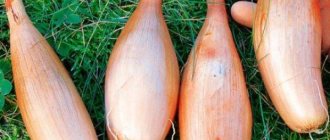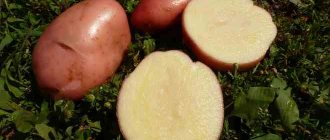Red Rose - Potato plant variety
Variety characteristics:
Properties of the Red Rose variety:
Recommended region on the map:
Information on the admission of Red Rose Potatoes from the Register of the State Variety Commission of the Russian Federation
Application for admission No. 31859, registered 1998-12-01. The Red Rose Potato variety was included in the register of approved varieties in 2001. Approved for use in the regions: North Caucasus.
The originator of the Red Rose Potato variety is:
- FSBSI `Research Institute of Potato Farming NAMED AFTER A.G. LORHA` (140052, MOSCOW REGION, Luberetskiy DISTRICT, P/O KRASKOVO, STREET LORHA, 23)
Other plant varieties Potato
Variety selection
Question to the expert
If you haven't found the answer to a question, don't hesitate to ask an expert.
Add new comment
Register or Login so you don't have to enter your Name and Email every time
Thanks for the comment! It will be published after checking by a moderator!
Comments
No comments yet, be the first!
A portal for those who love their dacha
Thanks for your question!
Your question has been sent for moderation. Don't worry, we quickly check your questions and your question will be answered within 1 day.
We have noticed that you are already registered on our website. We recommend that you log in to view the question you created. If you don't remember your password, you can recover it.
You were not registered until today, so we have registered you. Your password has been sent to your specified mailbox.
Help our site develop!
Please read this message, it will not take up much of your time!
We so need your comments and questions to understand in which direction we should develop.
Don't forget to leave a comment if you found what you were looking for. And if you haven’t found it, use the “Ask an Expert” form in the site header. We will answer this question, and other visitors will be able to find the information that you could not find.
Sincerely, team of the portal Dacha-Dacha.ru
Thanks for your question!
Your question has been sent for moderation. Don't worry, we quickly check your questions and your question will be answered within 1 day.
We have noticed that you are already registered on our website. We recommend that you log in to view the question you created. If you don't remember your password, you can recover it.
Article on the topic: Potato variety “Zorachka” - description and photo
You were not registered until today, so we have registered you. Your password has been sent to your specified mailbox.
Features of cultivation
Bellarosa potatoes do not need watering, as they easily tolerate even prolonged drought. But the variety requires regular fertilizing. And since fertilizers cannot be applied to dry soil, this should be done after rain or after moistening. During the period of active growth of bushes, chicken manure 1:15 or ammonium nitrate 30 g per bucket should be used. At the stage of formation of buds and ovaries, superphosphate (40 g) and potassium sulfide (25 g) for the same volume of liquid should be used for feeding.
Fertilizers should be applied at the roots, and after the bushes close, by spraying on the leaves.
During the early growth stage, weeds should be removed regularly to prevent them from taking away moisture and nutrients. After the bushes grow, the need for this will completely disappear.
10 days after planting Bellarosa, you need to loosen the soil in the garden bed for the first time to prevent the formation of a crust on the surface. Potatoes should be hilled twice. The first time is at the stage of sprout height of 10-14 cm, and the second time is 2 weeks after the previous one.
Bellarosa does not produce small tubers
The history of the origin of the Crimean Rose potato variety
The Crimean rose potato was bred by amateur breeders. It was not included in the State Register of Breeding Achievements, so this variety did not pass tests on industrial fields. The Crimean rose potato is popular among farmers and gardeners - it is readily grown in subsidiary plots and on farm plots.
The variety grows well in areas with hot climates. Potatoes are grown mainly in Crimea, but planting is possible in any arid regions.
The table presents data on starch content in different varieties:
Rules for planting Belarusians
White Rose potatoes should be planted on well-prepared, light, well-fertilized soils characterized by high-quality breathability. For very early cultivation, it is recommended to germinate potato tubers of this variety.
When planting early varieties used both for summer consumption and for storage in winter, certain rules should be followed:
- the area for potatoes should be prepared starting in the fall, when the soil is dug deep and the maximum amount of fertilizer is applied;
- in the spring, if necessary, depending on the condition of the soil on the site, repeated digging, leveling the surface and marking the rows along the line should be carried out;
- It is recommended to place planting holes at a distance of 25-30 cm, maintaining a distance between rows of 60-65 cm;
- Before lowering the seed tubers into the holes, you should pour about 0.5 kg of humus into each hole with the addition of 1 tbsp. l. wood ash;
- After completion of planting work, the soil surface in the area is carefully leveled with a rake.
A special feature of the White Rose variety is its ability to demonstrate high yields on different types of soil. This variety is absolutely not susceptible to adverse weather conditions, and also does not suffer from stress as a result of drought and high temperatures, which makes it popular as a starter variety for growing by inexperienced gardeners.
Description of the variety
Crimean rose is an early ripening potato variety. In hot areas, you can get two vegetable harvests in one season.
Main characteristics of the Crimean Rose potato:
- Resistance to drought and heat;
- The ripening period is 60 days;
Starch content varies from 14% to 17%.
- Weight of commercial tubers – 75-120 grams;
- Good taste;
- 10-15 tubers per bush;
- The peel is pink, the flesh is white or cream-colored;
- Resistance to potato cancer, common scab, blackleg;
- The variety produces the greatest yield on light sandy soils;
- Tolerates drought and heat well.
REFERENCE: Systematic watering will increase potato yields.
Potatoes "White Rose": harvesting ( )
In addition, the “White Rose” variety has increased crop shelf life, which is perfectly preserved throughout the winter, and is also characterized by minimal susceptibility to mechanical damaging factors. Most often, this high-yielding, ultra-early table variety is grown for the purpose of very early delivery of potatoes to vegetable markets. High agricultural technology allows you to get a plentiful and high-quality harvest.
The best potato varieties for 2021: the most delicious and productive
Vegetables such as potatoes are considered second bread. It can be an independent dish or act as one of its components. To get a rich and high-quality potato harvest in 2021, when choosing a variety, it is important to take into account the climate of the area.
Advantages and disadvantages
The main advantages of Crimean Rose potatoes:
- Early ripening of tubers;
- Good taste;
- High yield;
- Heat and drought resistance;
- High content of vitamins, protein, minerals and amino acids;
- Possibility of long-term storage;
- Resistance to major potato diseases.
The disadvantages of the variety include:
- Unevenness of tubers - many small potatoes are tied under the bush;
- The characteristic bumpiness of potatoes impairs their presentation.
REFERENCE: The variety is not entirely suitable for sale - it is mainly grown on subsidiary plots for personal consumption.
Collection, storage and use of crops
The first digging of Crimean rose potatoes is carried out 40 days after full germination. Tubers reach technical maturity at 60-80 days. They are sorted and dried under a canopy, protected from direct sunlight, otherwise they will turn green.
Reference. The green color of the tubers is a sign of the presence of corned beef, a compound toxic to humans.
The harvest is stored in a cool place in boxes. Tubers do not lose their presentation and do not germinate for 3-4 months at a temperature of +4-6°C and an air humidity of 80-90%.
In the warm climate of Crimea and other southern regions, you can dig young potatoes until late autumn.
The product has an attractive appearance, excellent taste and pronounced aroma. The tubers grow small and medium in size. The skin is easy to clean, the pulp does not boil over and retains its structure. For lovers of small young potatoes, Crimean Rose is the ideal variety.
Peculiarities
Crimean rose is an early ripening potato. The ripening period of the vegetable is 60-70 days from germination. You can dig the first tubers after 40 days.
The harvest can be stored for several months without losing its taste.
The bush is medium-sized, wide and spreading. The leaves are small, dark green in color with pronounced veins and slightly wavy edges.
The corolla consists of large cream-colored flowers; berries are rarely set. The variety is distinguished by a well-developed root system - at least 10-15 tubers are formed under the bush.
Related article: Potato variety “Blue Danube” - description and photo
IMPORTANT: The seed material does not degenerate - tubers for planting can be collected every year.
Characteristics of the variety
The Crimean Rose potato variety is an early-ripening table potato.
From the emergence of seedlings to the full maturation of the tubers, 70-80 days pass. The first root crops can be dug up after 40 days, but its highest yield by the end of the growing season.
The harvested crop is well stored without losing its consumer properties for several months. Transportation possible. Seed material is not subject to degeneration ; tubers for subsequent plantings can be collected independently from year to year.
The potato bush is medium-sized, compact, erect, with moderately spreading branches. The formation of green mass is average. The leaves are medium-sized, dark green, of an intermediate type, with clearly defined veins and slightly wavy edges.
The corolla is made up of large creamy white flowers. They fall off quickly and rarely set berries. The root system is well developed, 10-15 tubers are formed under each bush.
The table below shows the number of tubers in the bushes and their marketable weight for other potato varieties:
| Variety name | Number of tubers in a bush (pcs) | Their sales weight (g) |
| Lady Claire | up to 15 | 85-110 |
| Innovator | 6-11 | 120-150 |
| Labella | up to 14 | 80-100 |
| Bellarosa | 8-9 | 120-200 |
| Riviera | 8-12 | 100-180 |
| Karatop | 16-25 | 60-100 |
| Veneta | 10-12 | 70-100 |
| Gala | up to 25 | 100-140 |
Growing Crimean Rose potatoes is not particularly difficult. It prefers light soils and tolerates heat or lack of moisture. Timely watering helps increase the mass of tubers and significantly increase yield.
Frequent hilling is recommended, as well as fertilizing with mineral or organic fertilizers.
Read about how and when to apply fertilizers, as well as how to feed plants when planting, in separate articles on the site.
When planted in early spring, the harvest can be harvested as early as June. Many gardeners manage to get 2 harvests per season .
Potatoes are resistant to many dangerous diseases : potato cancer, various viruses, blackleg, common scab. Rarely affected by late blight or bacterial infections. The seed material does not degenerate, retaining all the properties of the mother plants.
Crimean Rose potatoes have a great taste: delicate, balanced, bright. The tubers are neither watery nor dry, they are suitable for preparing a wide variety of dishes.
The moderate starch content prevents root vegetables from overcooking and they retain their neat shape. When cutting and cooking, the tubers do not darken. Potatoes can be boiled, fried, stewed or baked and produce a delicious, fluffy, creamy white puree.
The table below provides data on the starch content of other potato varieties:
| Variety name | Starch content |
| Zhukovsky early | 10-12% |
| Lorch | 15-20% |
| Limonka | 8-14% |
| Melody | 11-17% |
| Margarita | 14-17% |
| Aladdin | up to 21% |
| Courage | 13-20% |
| Beauty | 15-19% |
| Grenada | 10-17% |
| Mozart | 14-17% |
Correct fit
In hot and dry places, potatoes are planted early - in the second half of March. In the middle zone, it is recommended to plant the vegetable no earlier than the end of May.
For planting, smooth, medium-sized tubers that are not damaged by insects or diseases are selected.
The selected planting material must be pickled and soaked in water with the addition of a growth stimulator. Then the tubers are germinated in wet sawdust. The entire germination procedure takes about a month. Sawdust must be frequently sprayed with a stimulating solution or water.
Before planting root crops, the soil is thoroughly loosened and cleared of tops and plant debris. Humus or wood ash also needs to be added to the soil for nutritional benefits.
IMPORTANT: The soil should warm up very well, but not be too dry.
Sprouted potatoes are laid out along with sawdust in the holes. The bushes should be 30 cm apart from each other. Wide row spacing must be provided.
Planted root crops should be covered with plastic wrap to protect them from night frosts. During the season, potato bushes need to be hilled several times. When watering, the soil should be moistened to a depth of 50-60 cm. There is no need to add fertilizers to the soil - during the rapid period of potato ripening, the nutrients added to the soil before planting are sufficient.
Features of care
This type of potato does not require care, but it is worth paying a little attention to. Gardeners advise carrying out simple maintenance activities.
- During the entire growing season, the plants are hilled 2-3 times.
- Be sure to water the area, but no more than 50 cm deep.
- Fertilizers do not need to be applied. In a short time of ripening, the plant manages to absorb all the useful elements that were added at the time of planting.
If you organize proper watering, you can increase the yield several times. If the summer is cold and rainy, the harvest may decrease and the fruits will lose their unique taste.
Diseases and pests
The Crimean rose variety is resistant to diseases such as:
- Common scab;
- Potato cancer;
- Blackleg.
Due to early ripening, tops and root crops are not susceptible to late blight.
For preventive purposes, it is necessary to periodically change the place where potatoes are planted and treat the planting material.
Vegetables are threatened by the following insect pests:
To protect against pests, potato bushes must be sprayed with biological products or insecticides.
We invite you to familiarize yourself with potato varieties that have different ripening periods:
Planting and care
According to consumer reviews, the Bellarosa variety is planted in various ways:
- into the ground,
- straw,
- on the ridges,
- into the holes.
At any planting, potatoes give excellent germination.
A good result is provided by the soil after buckwheat, oats, and mustard. Pre-planting these crops before potatoes enriches the soil with the necessary nutrients.
Preparing for landing
Bellarosa is planted in the ground at the end of April, if weather conditions permit (later in the northern regions). Before sowing, the tubers are allowed to germinate, this speeds up the process of shoot emergence. To do this, at the end of March (about 2 weeks before planting) preparatory measures are carried out:
- tubers are inspected for the presence of eyes (rotten, shriveled, moldy specimens are not used);
- the selected material is placed in a dry room with a temperature not lower than 13-15 degrees Celsius;
- polyethylene is laid out on the floor, potatoes are distributed on it in one layer;
- a vitamin-prophylactic biologically active solution is diluted in water (to accelerate growth, increase immunity, protect against pests) and evenly spray the planting material;
- When the sprouts have reached 2-4 cm, the potatoes are planted.
On a note. Spraying tubers is not a mandatory procedure, but doing it can make the growing process easier. At the same time, you don’t have to worry about treating a grown potato plantation with insecticides due to damage by Colorado potato beetle larvae.
Landing
You can visually determine the readiness of the soil for planting:
- there should be no snow crust on the surface;
- the humidity level should not be too high (your feet will not get stuck in the mud);
- when compressed, the earthen lump crumbles into lumps (but does not turn into dust).
The hole layout is standard:
Name Distance, cm Distance between rows 85-95 Interval between holes 35-40 Laying depth 15-17 (per bayonet of a shovel)
Sequence of planting work:
- The soil is harrowed or holes are dug with a shovel by hand.
- Natural fertilizers (onion peels, eggshells) or synthetic (phosphorus-potassium) are placed on the bottom.
- The potatoes are placed carefully so as not to break the sprouts.
- Dig in without pressing the soil down too hard.
- After planting, the soil is leveled (with a rake).
Watering and hilling
The plantation does not need to be watered often. It is enough to water 3 times, but generously:
- after receiving the first shoots;
- after hilling during the period of active growth;
- after flowering during the period of bud formation.
The soil between the young bushes is loosened, removing weeds. Hilling up Bellarosa begins after the tops reach a height of 15 cm. To do this, using a hand hoe, soil is raked to the base of the bush on both sides, forming parallel ridges.
Fertilizer
To obtain a bountiful harvest, the soil is fertilized according to the following scheme:
- the first fertilizer is applied before sowing (immediately during planting);
- after the green leaves appear, fertilize with infusion of chicken manure (organic nitrogen fertilizer);
- before flowering, treat with urea or infusion of ash;
- During flowering, you can add a phosphate composition.
Recommendation. Fertilizer is applied to well-moistened soil. The best option is after rain or heavy watering.
Pest and disease control
The characteristics of Bellarosa potatoes allow you not to worry about damage from viral and fungal diseases. To preserve tubers and crops from attack by beetles, mole crickets, and wireworms, preventive treatment before planting is sufficient. If such an event has not been carried out, spraying with special means is used only before flowering.
Care after landing ( )
The good taste, disease resistance and hardiness of the German Bellarosa variety were appreciated by summer residents and farmers. Potatoes are suitable for cultivation in small suburban areas and for mass sowing in the field. In warm weather conditions, the harvest can be obtained as early as June.
Reviews about the variety
Farmers and gardeners who grow the Crimean Rose potato variety note the good taste of the vegetable. Root vegetables do not become soft when cooked. During cutting and cooking, potatoes do not darken for a long time. The Crimean rose variety is intended for frying, baking, boiling, and stuffing. The vegetable can be stored for a long time.
Crimean rose is a potato weed that grows well in arid regions and produces high yields.
Article on the topic: Potato variety “Colette” - description and photo
Reviews
I love Bellarosa very much - it is productive, it stores well, my basement is damp. Excellent in all dishes - boiled, even fried, in soup. The tubers are large, reaching up to 800 g. What is also important is that the variety is early. But it degenerates, you need to buy new seed potatoes every 3-4 years.
Our favorite potatoes! The super early variety Belarossa is the best, we plant in early May, we start digging in early July! Can be planted for 2 crops. Very large tubers, stable yield. Unpretentious, drought-resistant, our soil is poor, but still the harvest is pleasing. The peel is thin and easy to peel.
I have been planting belarosa for 4 years. Always happy with large tubers, small waste, but not enough seed potatoes. Among all my varieties, this one takes first place - it doesn’t fall apart when fried, it’s tasty, it doesn’t darken. There was a problem one year - it rained a lot, and then the heat came and there was a lot of rot. Now there are no varieties that can be planted for 10 years in a row, maximum 2-3 years.
A variety without surprises - it always pleases with high yields and large potatoes. I have been growing it for many years, for myself and for sale - they always get good results. It is best suited for frying. The main problem of Belarusian blight is late blight, we need to fight it in time. I wish you all good harvests!
My neighbor, a scientist agronomist, advises updating the varieties with super-elite, not contaminated ones, and never cutting potatoes. On our sandy soils, you only need to plant early and mid-early potatoes; they will have time to set before the heat gets hot. I plant Bellarosa and Tiras. They are the most productive and have an excellent taste. There are 4-6 potatoes per bush, but large ones! Harvest – 250-270 kg per hundred square meters. I plant on April 1st. We have enough rain, I don’t water, I don’t weed. I burnish it 2 times - the first time when the shoots just appear.
Citizen gardeners, Bellarosa is an excellent variety, but it does not like heat and degenerates quickly. It needs to be planted in the shade; I always plant it under a fence, under rows of cucumbers, so that they get shade for at least part of the day. After the first hilling, you can sow green manure in the row spacing. There are few tubers, but they are tubers, I ate one and was full. Another good variety is Bozhedar, also early and productive, but we like the taste better.
Harvesting and storage
Bellarosa potatoes ripen towards the end of July. A characteristic sign of this is the withering of the shoots; you need to dig in dry weather. After this, leave the potatoes in the garden for 2-3 hours so that they dry slightly. Before storing in the basement, the crop must be kept for 2-3 weeks in a dry room and sorted, discarding tubers that are unsuitable for long-term storage. You should also sort by size.
Important! Optimal storage conditions: temperature +4-+6 degrees, humidity – 80%.











